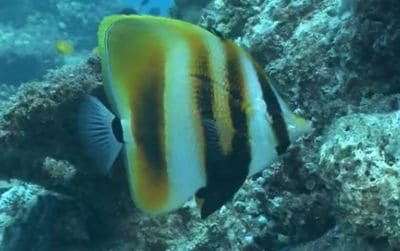Home › Sea Life › Marine Species › Vertebrates › Butterfly Fish › Highfin Coralfish
Interesting Facts about Highfin Butterflyfish
[Phylum: Chordata] [Class: Actinopterygii] [Order: Acanthuriformes] [Family: Chaetodontidae]
Coradion altivelis (sometimes called the tawneygirdled coralfish) is one of the reef-dwelling butterflyfishes known for its tall dorsal fin, sponge-focused diet, and wide ranging Indo-West Pacific distribution.
Check out these highfin coralfish facts, including where they are found, what they eat, and how these marine ray-finned fish from the family Chaetodontidae reproduce.
Highfin Coralfish Habitat and Global Range
Even though their geographic range is somewhat sketchy, they swim together in large numbers in some locations, especially:
- Andaman Sea (including Sunda Islands, western Indonesia)
- The Gulf of Thailand
- Southern Japan
- Northern Australia (the Great Barrier Reef, Papua New Guinea)
Within these ranges, the density of the species tends to be dependent on available sea sponges and coral reef condition.
Being strongly associated with coral reef networks means they are mostly found near outer reef slopes, drop-offs, and in areas where coral growth is abundant and healthy.
Furthermore, Coradion altivelis is a species that can tolerate shallow coastal reefs with silty or sediment-influenced substrates, typically at depths ranging between three (3) and thirty (30) metres (98 feet).
Highfin Butterflyfish Characteristics
As you should expect from the common name, the vertically extended dorsal fin is notably taller than some of the other Coradion species, such as the orange-tailed coralfish.
Plus, the vertical orange-brown stripe pattern is narrow and clean, and it contrasts nicely with the pale background coloration.
The closely related orangebanded coralfish (Coradion chrysozonus) is quite similar in appearance, but their stripes are less refined and more widely spaced.
The Ocellus (False Eyespot)
Even though some kind of eyespot on the dorsal fin area is common in butterfly fish (Chaetodontidae), the ocellus tends to be more subtle in highfin coralfish.
 Besides that, another characteristic is the pair-forming traits seen in adults when they develop long-term monogamous bonds.
Besides that, another characteristic is the pair-forming traits seen in adults when they develop long-term monogamous bonds.
Highfin Butterflyfish Size
A measurement taken from the tip of the snout (nose) to the end of the tail would show the maximum size of fully grown Coradion altivelis as eighteen (18) centimetres (less than 8 inches).
What Do Highfin Coralfish Eat?
The core diet for many types of butterfly fish is sponges. You may see them pick at different species of encrusting and filamentous sponges.
Some supplement their food with small benthic invertebrates, especially segmented worms and crustaceans that live in, or near, sea squirts and sponge mats.
Reproduction in Coradion altivelis
Pair bonding is an important part of highfin coralfish reproductive strategy, and it's common for them to maintain long-term partnerships.
The pairs will forage together and work with one another to defend small territories, setting the stage for events of synchronised spawning.
Here's the thing:
All butterflyfish species are broadcast spawners, they release large numbers of buoyant, pelagic eggs into the open water near to the surface.
The eggs float with planktonic organisms in the currents until they hatch, usually within a day of fertilisation taking place.
Following that, the tiny fry enter the postlarval stage of Chaetodontidae and Scatophagidae (also called tholichthys stage). Simply put, large, bony armour plates extend from the head and cover the rest of the body in some of the postlarval fish species until they reach maturity.
Juveniles tend to settle around sheltered, sponge-rich rubble areas most often. Here, they will get some protection during their development of their foraging behaviour.
Coralfish Predators and Threats
Even though butterflyfishes can enjoy a healthy lifespan up to ten (10) years in the wild, the ones kept as marine aquarium pets tend to have shorter lifetimes.
On top of that, they face some significant threats from predatory fish species outside of captivity. For instance, the main hunters of the coralfish species are:
- Emperor fish (Lethrinidae)
- Grouper (especially leopard coral groupers)
- Moray eels
- Sharks (especially blacktips and whitetip reef sharks)
- Snappers (Lutjanidae)
Other contributing factors for the decline in a few vulnerable areas include certain types of human behaviour (e.g. coral reef destruction and degradation, overfishing).
Having a vivid and conspicuous colouration means they are popular fish for aquarium hobbyists to keep as pets.
In 2009, the International Union for Conservation of Nature (IUCN) assessed highfin coralfish (Coradion altivelis) as "Least Concern" (LC) with a "Stable" population trend.